Sainsbury's Digital Technology Strategy: Impacts and Challenges
VerifiedAdded on 2024/06/27
|21
|4322
|162
Report
AI Summary
This report examines the effects of digital technology on Sainsbury's business operations, focusing on how these technologies drive sales and enhance customer connections. It begins with an introduction to the research, outlining the background, aim, objectives, research questions, and rationale. The literature review explores Sainsbury's business operations, providing an overview of digital technology and its impact, specifically addressing cloud technology, social media technology, big data analytics, and artificial intelligence. The research methodology chapter details the research philosophy, approach, purpose, data collection techniques, data analysis method, sampling techniques, ethical considerations, limitations, and timescale. The report aims to provide a comprehensive analysis of how Sainsbury's uses digital technologies to improve its market position and customer experience, while also addressing the challenges associated with these implementations.
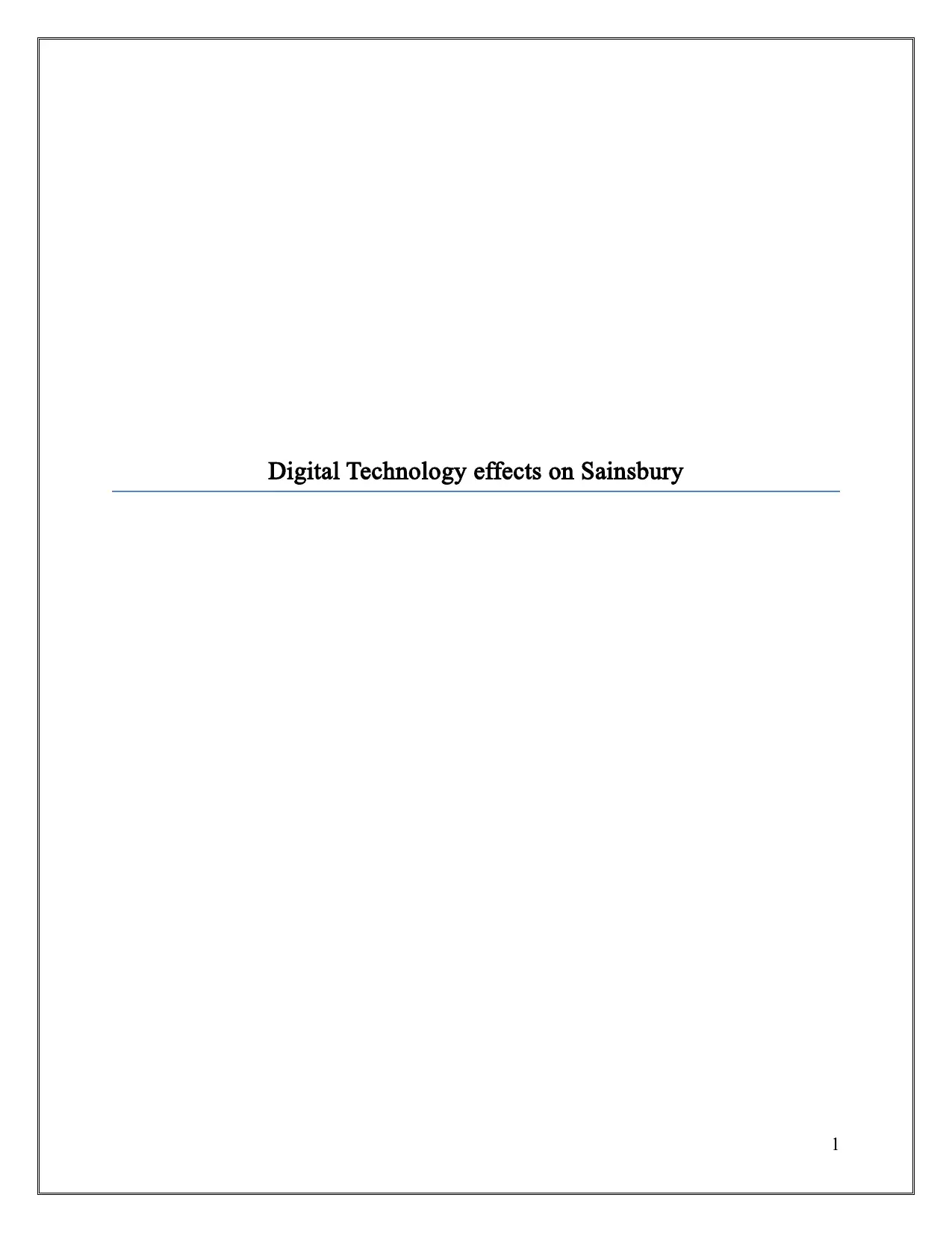
Digital Technology effects on Sainsbury
1
1
Paraphrase This Document
Need a fresh take? Get an instant paraphrase of this document with our AI Paraphraser
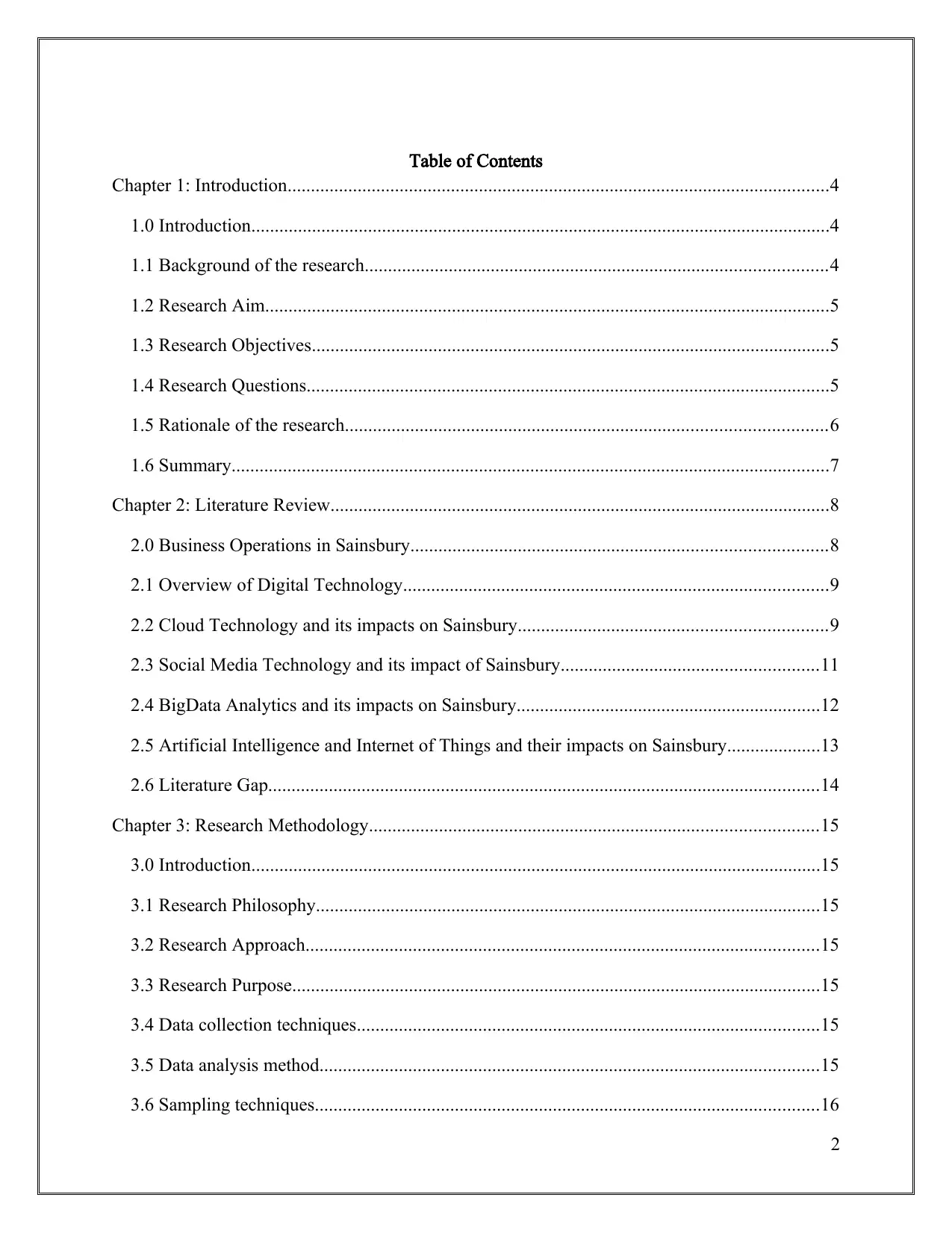
Table of Contents
Chapter 1: Introduction....................................................................................................................4
1.0 Introduction............................................................................................................................4
1.1 Background of the research...................................................................................................4
1.2 Research Aim.........................................................................................................................5
1.3 Research Objectives...............................................................................................................5
1.4 Research Questions................................................................................................................5
1.5 Rationale of the research.......................................................................................................6
1.6 Summary................................................................................................................................7
Chapter 2: Literature Review...........................................................................................................8
2.0 Business Operations in Sainsbury.........................................................................................8
2.1 Overview of Digital Technology...........................................................................................9
2.2 Cloud Technology and its impacts on Sainsbury..................................................................9
2.3 Social Media Technology and its impact of Sainsbury.......................................................11
2.4 BigData Analytics and its impacts on Sainsbury.................................................................12
2.5 Artificial Intelligence and Internet of Things and their impacts on Sainsbury....................13
2.6 Literature Gap......................................................................................................................14
Chapter 3: Research Methodology................................................................................................15
3.0 Introduction..........................................................................................................................15
3.1 Research Philosophy............................................................................................................15
3.2 Research Approach..............................................................................................................15
3.3 Research Purpose.................................................................................................................15
3.4 Data collection techniques...................................................................................................15
3.5 Data analysis method...........................................................................................................15
3.6 Sampling techniques............................................................................................................16
2
Chapter 1: Introduction....................................................................................................................4
1.0 Introduction............................................................................................................................4
1.1 Background of the research...................................................................................................4
1.2 Research Aim.........................................................................................................................5
1.3 Research Objectives...............................................................................................................5
1.4 Research Questions................................................................................................................5
1.5 Rationale of the research.......................................................................................................6
1.6 Summary................................................................................................................................7
Chapter 2: Literature Review...........................................................................................................8
2.0 Business Operations in Sainsbury.........................................................................................8
2.1 Overview of Digital Technology...........................................................................................9
2.2 Cloud Technology and its impacts on Sainsbury..................................................................9
2.3 Social Media Technology and its impact of Sainsbury.......................................................11
2.4 BigData Analytics and its impacts on Sainsbury.................................................................12
2.5 Artificial Intelligence and Internet of Things and their impacts on Sainsbury....................13
2.6 Literature Gap......................................................................................................................14
Chapter 3: Research Methodology................................................................................................15
3.0 Introduction..........................................................................................................................15
3.1 Research Philosophy............................................................................................................15
3.2 Research Approach..............................................................................................................15
3.3 Research Purpose.................................................................................................................15
3.4 Data collection techniques...................................................................................................15
3.5 Data analysis method...........................................................................................................15
3.6 Sampling techniques............................................................................................................16
2
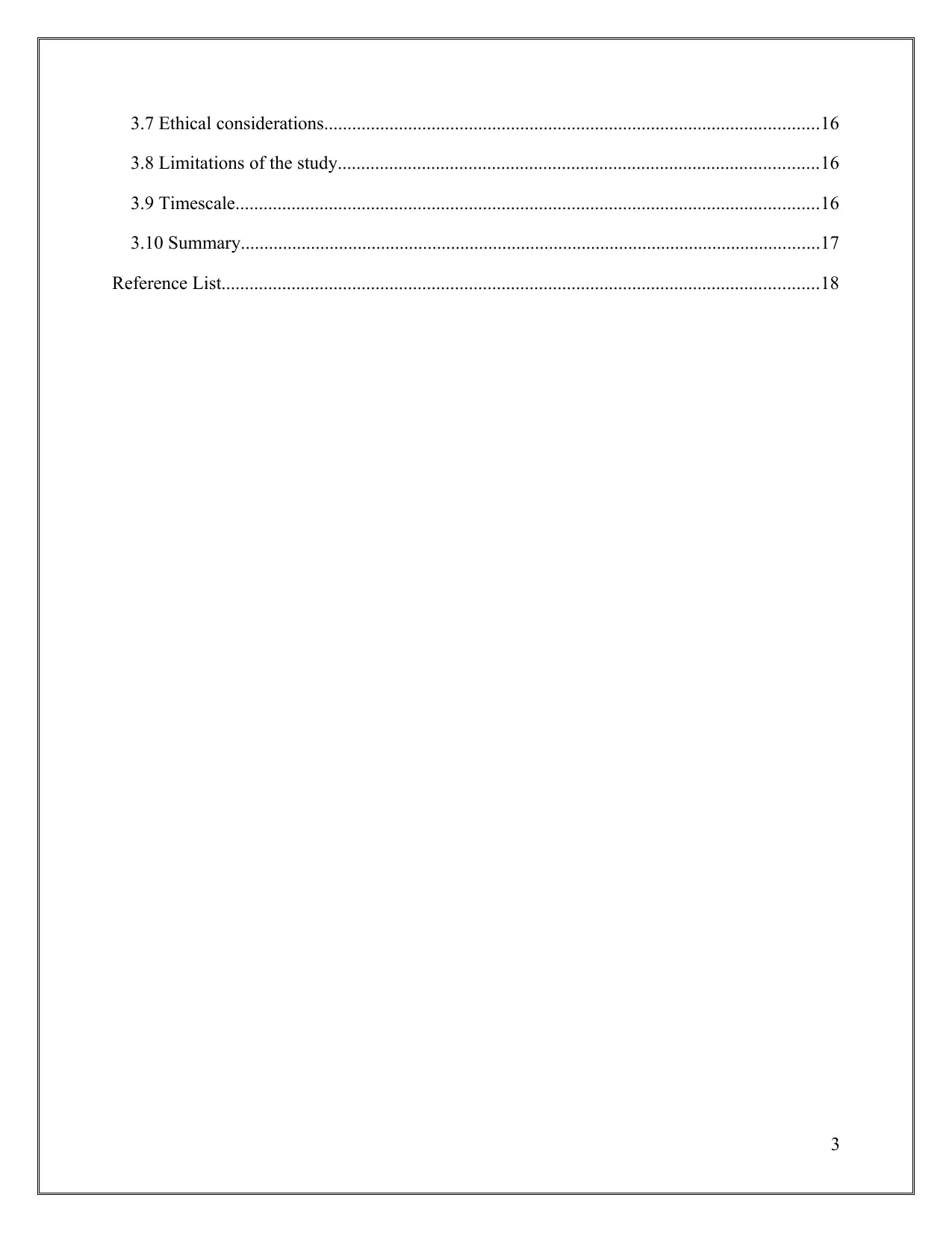
3.7 Ethical considerations..........................................................................................................16
3.8 Limitations of the study.......................................................................................................16
3.9 Timescale.............................................................................................................................16
3.10 Summary............................................................................................................................17
Reference List................................................................................................................................18
3
3.8 Limitations of the study.......................................................................................................16
3.9 Timescale.............................................................................................................................16
3.10 Summary............................................................................................................................17
Reference List................................................................................................................................18
3
⊘ This is a preview!⊘
Do you want full access?
Subscribe today to unlock all pages.

Trusted by 1+ million students worldwide
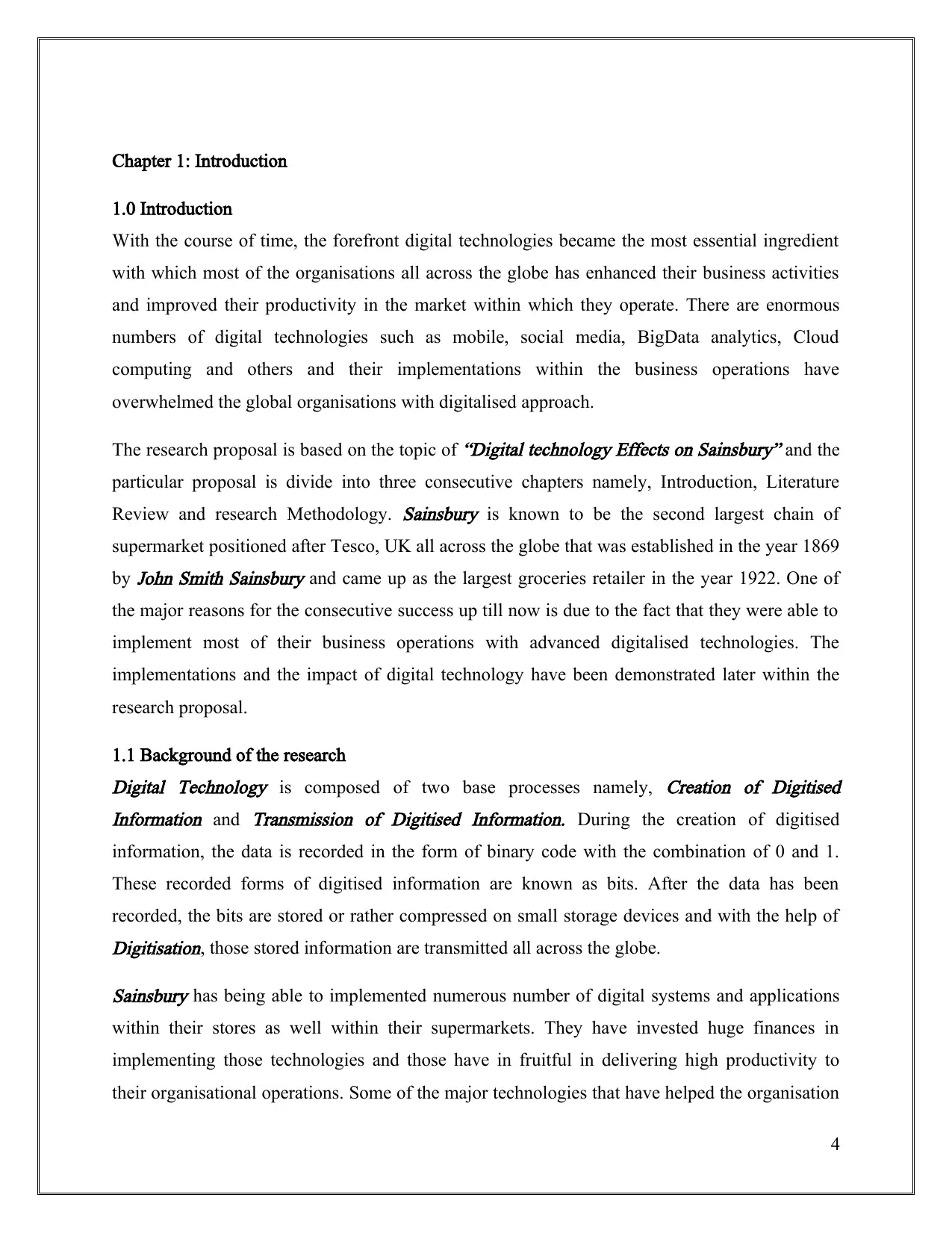
Chapter 1: Introduction
1.0 Introduction
With the course of time, the forefront digital technologies became the most essential ingredient
with which most of the organisations all across the globe has enhanced their business activities
and improved their productivity in the market within which they operate. There are enormous
numbers of digital technologies such as mobile, social media, BigData analytics, Cloud
computing and others and their implementations within the business operations have
overwhelmed the global organisations with digitalised approach.
The research proposal is based on the topic of
“Digital technology Effects on Sainsbury” and the
particular proposal is divide into three consecutive chapters namely, Introduction, Literature
Review and research Methodology.
Sainsbury is known to be the second largest chain of
supermarket positioned after Tesco, UK all across the globe that was established in the year 1869
by
John Smith Sainsbury and came up as the largest groceries retailer in the year 1922. One of
the major reasons for the consecutive success up till now is due to the fact that they were able to
implement most of their business operations with advanced digitalised technologies. The
implementations and the impact of digital technology have been demonstrated later within the
research proposal.
1.1 Background of the researchDigital Technology is composed of two base processes namely,
Creation of Digitised
Information and
Transmission of Digitised Information. During the creation of digitised
information, the data is recorded in the form of binary code with the combination of 0 and 1.
These recorded forms of digitised information are known as bits. After the data has been
recorded, the bits are stored or rather compressed on small storage devices and with the help ofDigitisation, those stored information are transmitted all across the globe.
Sainsbury has being able to implemented numerous number of digital systems and applications
within their stores as well within their supermarkets. They have invested huge finances in
implementing those technologies and those have in fruitful in delivering high productivity to
their organisational operations. Some of the major technologies that have helped the organisation
4
1.0 Introduction
With the course of time, the forefront digital technologies became the most essential ingredient
with which most of the organisations all across the globe has enhanced their business activities
and improved their productivity in the market within which they operate. There are enormous
numbers of digital technologies such as mobile, social media, BigData analytics, Cloud
computing and others and their implementations within the business operations have
overwhelmed the global organisations with digitalised approach.
The research proposal is based on the topic of
“Digital technology Effects on Sainsbury” and the
particular proposal is divide into three consecutive chapters namely, Introduction, Literature
Review and research Methodology.
Sainsbury is known to be the second largest chain of
supermarket positioned after Tesco, UK all across the globe that was established in the year 1869
by
John Smith Sainsbury and came up as the largest groceries retailer in the year 1922. One of
the major reasons for the consecutive success up till now is due to the fact that they were able to
implement most of their business operations with advanced digitalised technologies. The
implementations and the impact of digital technology have been demonstrated later within the
research proposal.
1.1 Background of the researchDigital Technology is composed of two base processes namely,
Creation of Digitised
Information and
Transmission of Digitised Information. During the creation of digitised
information, the data is recorded in the form of binary code with the combination of 0 and 1.
These recorded forms of digitised information are known as bits. After the data has been
recorded, the bits are stored or rather compressed on small storage devices and with the help ofDigitisation, those stored information are transmitted all across the globe.
Sainsbury has being able to implemented numerous number of digital systems and applications
within their stores as well within their supermarkets. They have invested huge finances in
implementing those technologies and those have in fruitful in delivering high productivity to
their organisational operations. Some of the major technologies that have helped the organisation
4
Paraphrase This Document
Need a fresh take? Get an instant paraphrase of this document with our AI Paraphraser
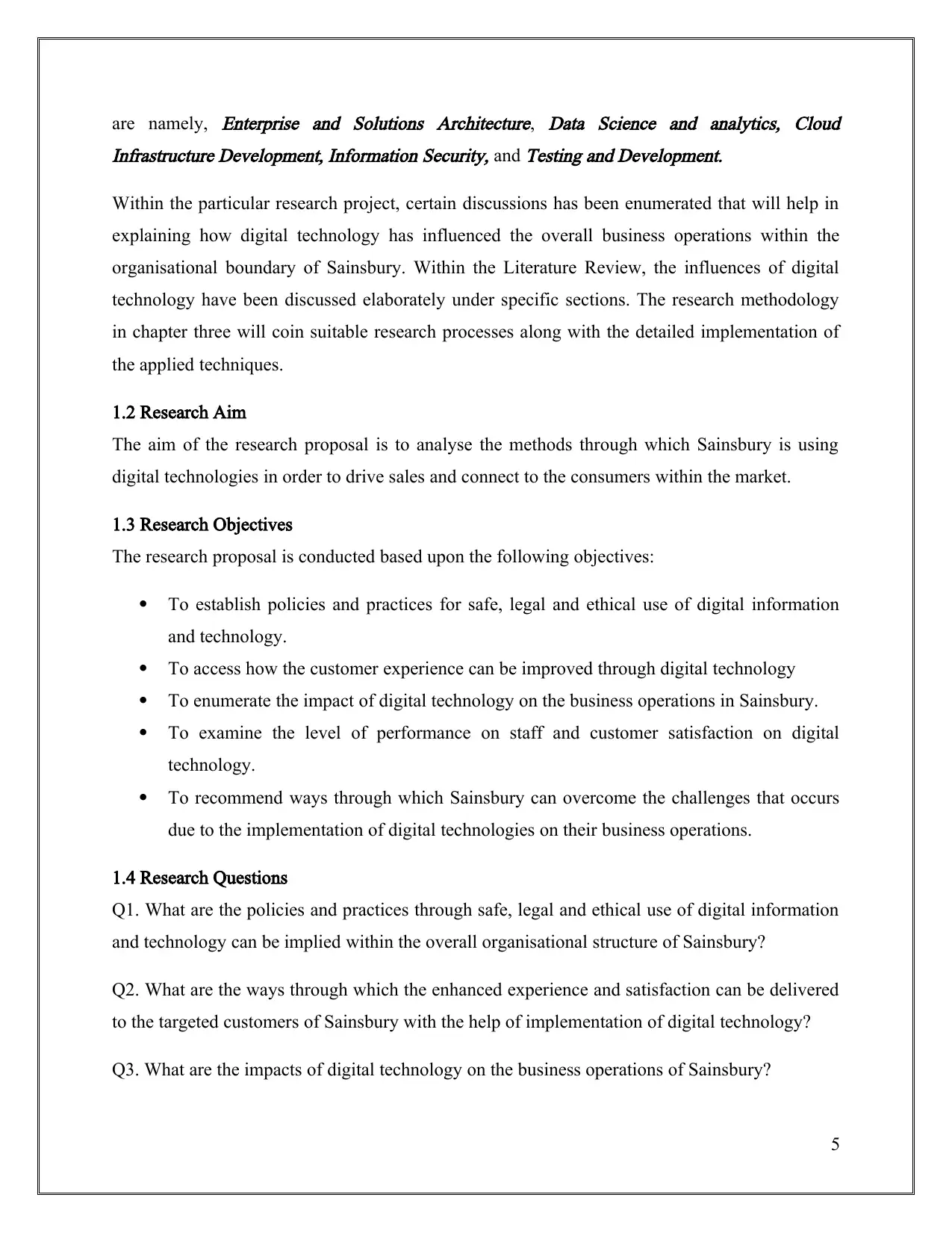
are namely,
Enterprise and Solutions Architecture,
Data Science and analytics, Cloud
Infrastructure Development, Information Security, and
Testing and Development.
Within the particular research project, certain discussions has been enumerated that will help in
explaining how digital technology has influenced the overall business operations within the
organisational boundary of Sainsbury. Within the Literature Review, the influences of digital
technology have been discussed elaborately under specific sections. The research methodology
in chapter three will coin suitable research processes along with the detailed implementation of
the applied techniques.
1.2 Research Aim
The aim of the research proposal is to analyse the methods through which Sainsbury is using
digital technologies in order to drive sales and connect to the consumers within the market.
1.3 Research Objectives
The research proposal is conducted based upon the following objectives:
To establish policies and practices for safe, legal and ethical use of digital information
and technology.
To access how the customer experience can be improved through digital technology
To enumerate the impact of digital technology on the business operations in Sainsbury.
To examine the level of performance on staff and customer satisfaction on digital
technology.
To recommend ways through which Sainsbury can overcome the challenges that occurs
due to the implementation of digital technologies on their business operations.
1.4 Research Questions
Q1. What are the policies and practices through safe, legal and ethical use of digital information
and technology can be implied within the overall organisational structure of Sainsbury?
Q2. What are the ways through which the enhanced experience and satisfaction can be delivered
to the targeted customers of Sainsbury with the help of implementation of digital technology?
Q3. What are the impacts of digital technology on the business operations of Sainsbury?
5
Enterprise and Solutions Architecture,
Data Science and analytics, Cloud
Infrastructure Development, Information Security, and
Testing and Development.
Within the particular research project, certain discussions has been enumerated that will help in
explaining how digital technology has influenced the overall business operations within the
organisational boundary of Sainsbury. Within the Literature Review, the influences of digital
technology have been discussed elaborately under specific sections. The research methodology
in chapter three will coin suitable research processes along with the detailed implementation of
the applied techniques.
1.2 Research Aim
The aim of the research proposal is to analyse the methods through which Sainsbury is using
digital technologies in order to drive sales and connect to the consumers within the market.
1.3 Research Objectives
The research proposal is conducted based upon the following objectives:
To establish policies and practices for safe, legal and ethical use of digital information
and technology.
To access how the customer experience can be improved through digital technology
To enumerate the impact of digital technology on the business operations in Sainsbury.
To examine the level of performance on staff and customer satisfaction on digital
technology.
To recommend ways through which Sainsbury can overcome the challenges that occurs
due to the implementation of digital technologies on their business operations.
1.4 Research Questions
Q1. What are the policies and practices through safe, legal and ethical use of digital information
and technology can be implied within the overall organisational structure of Sainsbury?
Q2. What are the ways through which the enhanced experience and satisfaction can be delivered
to the targeted customers of Sainsbury with the help of implementation of digital technology?
Q3. What are the impacts of digital technology on the business operations of Sainsbury?
5
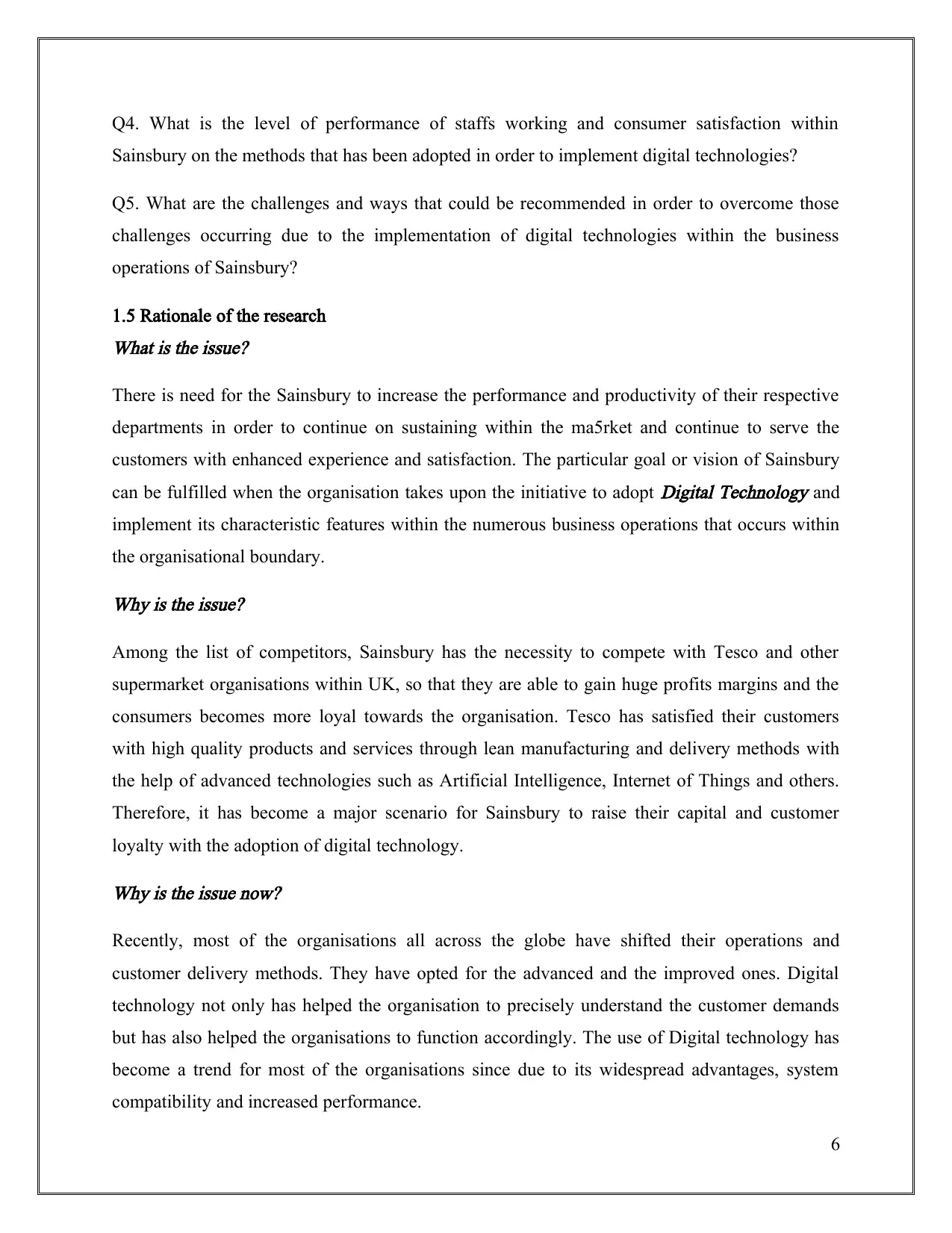
Q4. What is the level of performance of staffs working and consumer satisfaction within
Sainsbury on the methods that has been adopted in order to implement digital technologies?
Q5. What are the challenges and ways that could be recommended in order to overcome those
challenges occurring due to the implementation of digital technologies within the business
operations of Sainsbury?
1.5 Rationale of the researchWhat is the issue?
There is need for the Sainsbury to increase the performance and productivity of their respective
departments in order to continue on sustaining within the ma5rket and continue to serve the
customers with enhanced experience and satisfaction. The particular goal or vision of Sainsbury
can be fulfilled when the organisation takes upon the initiative to adopt
Digital Technology and
implement its characteristic features within the numerous business operations that occurs within
the organisational boundary.
Why is the issue?
Among the list of competitors, Sainsbury has the necessity to compete with Tesco and other
supermarket organisations within UK, so that they are able to gain huge profits margins and the
consumers becomes more loyal towards the organisation. Tesco has satisfied their customers
with high quality products and services through lean manufacturing and delivery methods with
the help of advanced technologies such as Artificial Intelligence, Internet of Things and others.
Therefore, it has become a major scenario for Sainsbury to raise their capital and customer
loyalty with the adoption of digital technology.
Why is the issue now?
Recently, most of the organisations all across the globe have shifted their operations and
customer delivery methods. They have opted for the advanced and the improved ones. Digital
technology not only has helped the organisation to precisely understand the customer demands
but has also helped the organisations to function accordingly. The use of Digital technology has
become a trend for most of the organisations since due to its widespread advantages, system
compatibility and increased performance.
6
Sainsbury on the methods that has been adopted in order to implement digital technologies?
Q5. What are the challenges and ways that could be recommended in order to overcome those
challenges occurring due to the implementation of digital technologies within the business
operations of Sainsbury?
1.5 Rationale of the researchWhat is the issue?
There is need for the Sainsbury to increase the performance and productivity of their respective
departments in order to continue on sustaining within the ma5rket and continue to serve the
customers with enhanced experience and satisfaction. The particular goal or vision of Sainsbury
can be fulfilled when the organisation takes upon the initiative to adopt
Digital Technology and
implement its characteristic features within the numerous business operations that occurs within
the organisational boundary.
Why is the issue?
Among the list of competitors, Sainsbury has the necessity to compete with Tesco and other
supermarket organisations within UK, so that they are able to gain huge profits margins and the
consumers becomes more loyal towards the organisation. Tesco has satisfied their customers
with high quality products and services through lean manufacturing and delivery methods with
the help of advanced technologies such as Artificial Intelligence, Internet of Things and others.
Therefore, it has become a major scenario for Sainsbury to raise their capital and customer
loyalty with the adoption of digital technology.
Why is the issue now?
Recently, most of the organisations all across the globe have shifted their operations and
customer delivery methods. They have opted for the advanced and the improved ones. Digital
technology not only has helped the organisation to precisely understand the customer demands
but has also helped the organisations to function accordingly. The use of Digital technology has
become a trend for most of the organisations since due to its widespread advantages, system
compatibility and increased performance.
6
⊘ This is a preview!⊘
Do you want full access?
Subscribe today to unlock all pages.

Trusted by 1+ million students worldwide

1.6 Summary
The particular chapter has brought forward the issue of the implementation of digital technology
over the business operations of Sainsbury. The objectives that have been created in order to
conduct the research proposal are aligned with the research aim and the theme of the research
proposal. The research questions that are prepared are according to the objectives and the overall
research and data evaluation will be conducted entirely upon these. The rationale of the research
has evidently coined the need of conducting the particular research project.
7
The particular chapter has brought forward the issue of the implementation of digital technology
over the business operations of Sainsbury. The objectives that have been created in order to
conduct the research proposal are aligned with the research aim and the theme of the research
proposal. The research questions that are prepared are according to the objectives and the overall
research and data evaluation will be conducted entirely upon these. The rationale of the research
has evidently coined the need of conducting the particular research project.
7
Paraphrase This Document
Need a fresh take? Get an instant paraphrase of this document with our AI Paraphraser
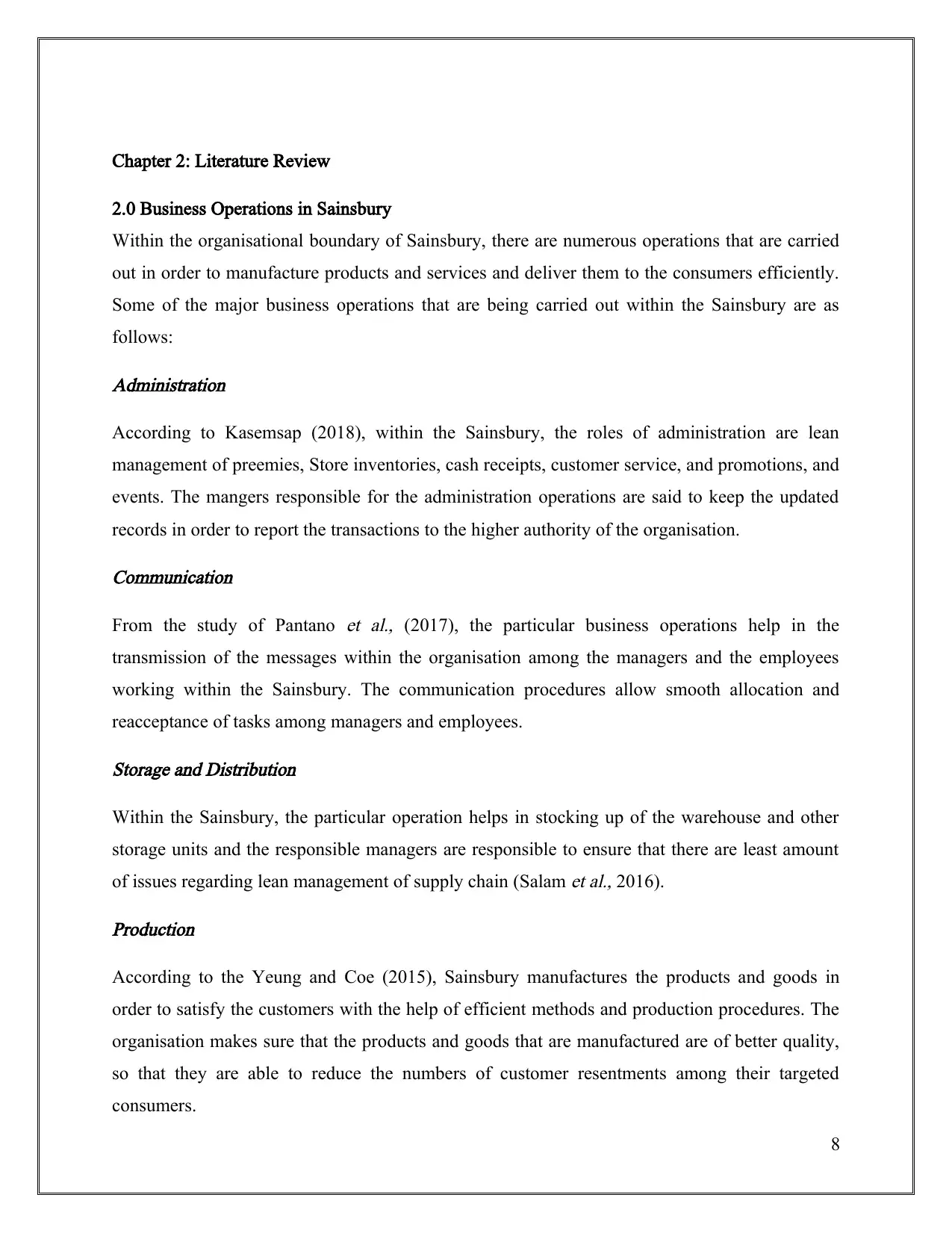
Chapter 2: Literature Review
2.0 Business Operations in Sainsbury
Within the organisational boundary of Sainsbury, there are numerous operations that are carried
out in order to manufacture products and services and deliver them to the consumers efficiently.
Some of the major business operations that are being carried out within the Sainsbury are as
follows:
Administration
According to Kasemsap (2018), within the Sainsbury, the roles of administration are lean
management of preemies, Store inventories, cash receipts, customer service, and promotions, and
events. The mangers responsible for the administration operations are said to keep the updated
records in order to report the transactions to the higher authority of the organisation.
Communication
From the study of Pantano
et al., (2017), the particular business operations help in the
transmission of the messages within the organisation among the managers and the employees
working within the Sainsbury. The communication procedures allow smooth allocation and
reacceptance of tasks among managers and employees.
Storage and Distribution
Within the Sainsbury, the particular operation helps in stocking up of the warehouse and other
storage units and the responsible managers are responsible to ensure that there are least amount
of issues regarding lean management of supply chain (Salam
et al., 2016).
Production
According to the Yeung and Coe (2015), Sainsbury manufactures the products and goods in
order to satisfy the customers with the help of efficient methods and production procedures. The
organisation makes sure that the products and goods that are manufactured are of better quality,
so that they are able to reduce the numbers of customer resentments among their targeted
consumers.
8
2.0 Business Operations in Sainsbury
Within the organisational boundary of Sainsbury, there are numerous operations that are carried
out in order to manufacture products and services and deliver them to the consumers efficiently.
Some of the major business operations that are being carried out within the Sainsbury are as
follows:
Administration
According to Kasemsap (2018), within the Sainsbury, the roles of administration are lean
management of preemies, Store inventories, cash receipts, customer service, and promotions, and
events. The mangers responsible for the administration operations are said to keep the updated
records in order to report the transactions to the higher authority of the organisation.
Communication
From the study of Pantano
et al., (2017), the particular business operations help in the
transmission of the messages within the organisation among the managers and the employees
working within the Sainsbury. The communication procedures allow smooth allocation and
reacceptance of tasks among managers and employees.
Storage and Distribution
Within the Sainsbury, the particular operation helps in stocking up of the warehouse and other
storage units and the responsible managers are responsible to ensure that there are least amount
of issues regarding lean management of supply chain (Salam
et al., 2016).
Production
According to the Yeung and Coe (2015), Sainsbury manufactures the products and goods in
order to satisfy the customers with the help of efficient methods and production procedures. The
organisation makes sure that the products and goods that are manufactured are of better quality,
so that they are able to reduce the numbers of customer resentments among their targeted
consumers.
8
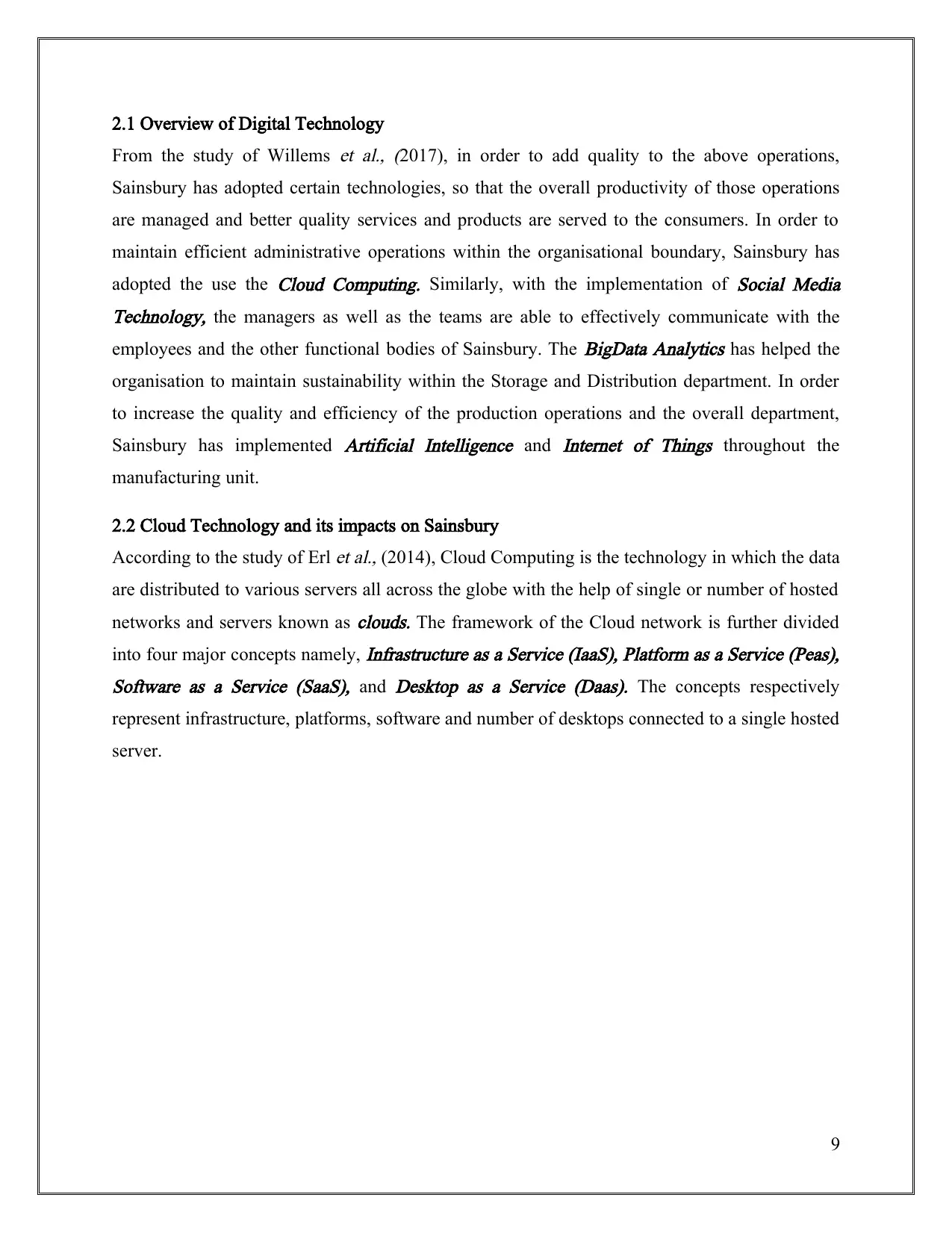
2.1 Overview of Digital Technology
From the study of Willems
et al., (2017), in order to add quality to the above operations,
Sainsbury has adopted certain technologies, so that the overall productivity of those operations
are managed and better quality services and products are served to the consumers. In order to
maintain efficient administrative operations within the organisational boundary, Sainsbury has
adopted the use the
Cloud Computing. Similarly, with the implementation of
Social Media
Technology, the managers as well as the teams are able to effectively communicate with the
employees and the other functional bodies of Sainsbury. The
BigData Analytics has helped the
organisation to maintain sustainability within the Storage and Distribution department. In order
to increase the quality and efficiency of the production operations and the overall department,
Sainsbury has implemented
Artificial Intelligence and
Internet of Things throughout the
manufacturing unit.
2.2 Cloud Technology and its impacts on Sainsbury
According to the study of Erl
et al., (2014), Cloud Computing is the technology in which the data
are distributed to various servers all across the globe with the help of single or number of hosted
networks and servers known as
clouds. The framework of the Cloud network is further divided
into four major concepts namely,
Infrastructure as a Service (IaaS), Platform as a Service (Peas),
Software as a Service (SaaS), and
Desktop as a Service (Daas). The concepts respectively
represent infrastructure, platforms, software and number of desktops connected to a single hosted
server.
9
From the study of Willems
et al., (2017), in order to add quality to the above operations,
Sainsbury has adopted certain technologies, so that the overall productivity of those operations
are managed and better quality services and products are served to the consumers. In order to
maintain efficient administrative operations within the organisational boundary, Sainsbury has
adopted the use the
Cloud Computing. Similarly, with the implementation of
Social Media
Technology, the managers as well as the teams are able to effectively communicate with the
employees and the other functional bodies of Sainsbury. The
BigData Analytics has helped the
organisation to maintain sustainability within the Storage and Distribution department. In order
to increase the quality and efficiency of the production operations and the overall department,
Sainsbury has implemented
Artificial Intelligence and
Internet of Things throughout the
manufacturing unit.
2.2 Cloud Technology and its impacts on Sainsbury
According to the study of Erl
et al., (2014), Cloud Computing is the technology in which the data
are distributed to various servers all across the globe with the help of single or number of hosted
networks and servers known as
clouds. The framework of the Cloud network is further divided
into four major concepts namely,
Infrastructure as a Service (IaaS), Platform as a Service (Peas),
Software as a Service (SaaS), and
Desktop as a Service (Daas). The concepts respectively
represent infrastructure, platforms, software and number of desktops connected to a single hosted
server.
9
⊘ This is a preview!⊘
Do you want full access?
Subscribe today to unlock all pages.

Trusted by 1+ million students worldwide
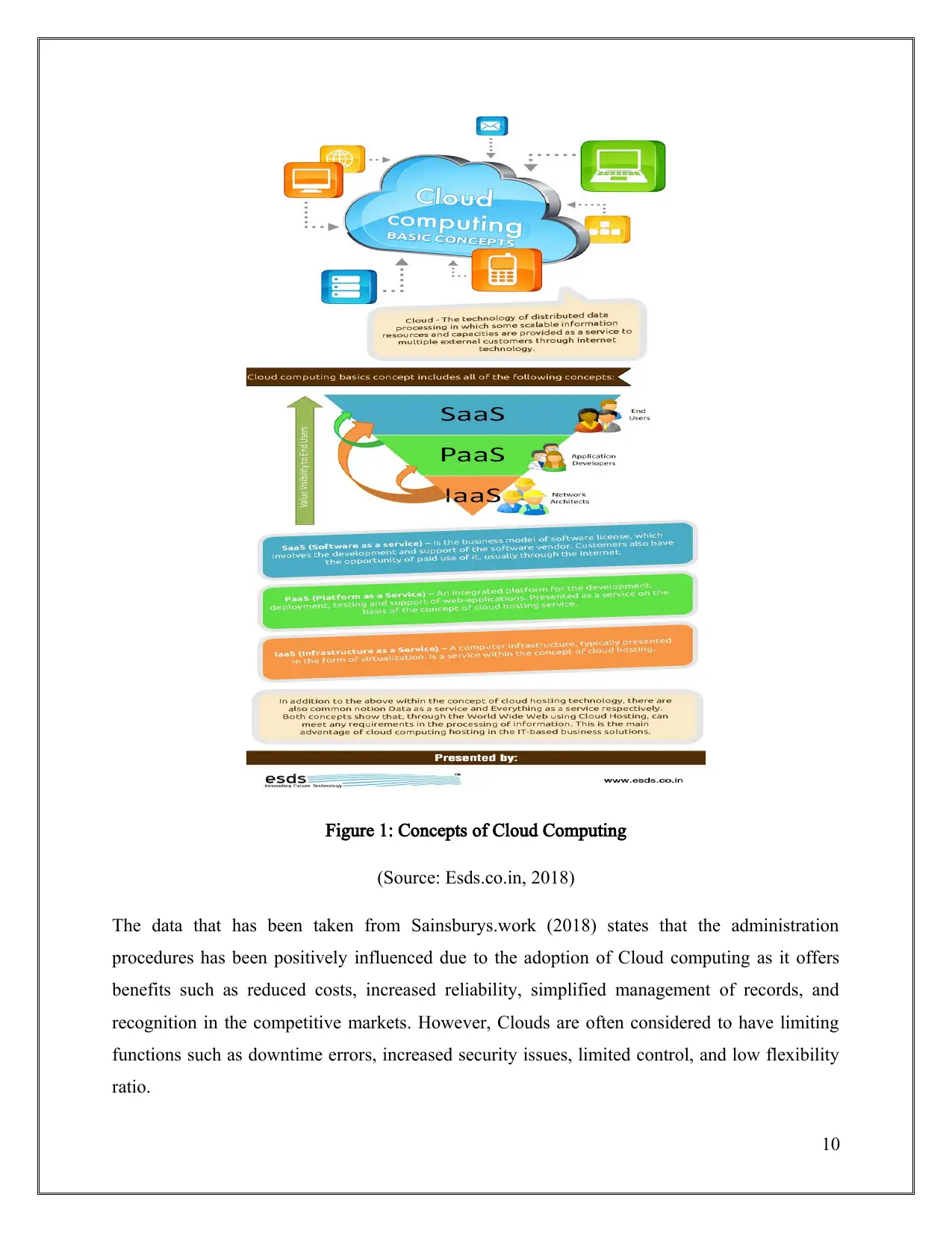
Figure 1: Concepts of Cloud Computing
(Source: Esds.co.in, 2018)
The data that has been taken from Sainsburys.work (2018) states that the administration
procedures has been positively influenced due to the adoption of Cloud computing as it offers
benefits such as reduced costs, increased reliability, simplified management of records, and
recognition in the competitive markets. However, Clouds are often considered to have limiting
functions such as downtime errors, increased security issues, limited control, and low flexibility
ratio.
10
(Source: Esds.co.in, 2018)
The data that has been taken from Sainsburys.work (2018) states that the administration
procedures has been positively influenced due to the adoption of Cloud computing as it offers
benefits such as reduced costs, increased reliability, simplified management of records, and
recognition in the competitive markets. However, Clouds are often considered to have limiting
functions such as downtime errors, increased security issues, limited control, and low flexibility
ratio.
10
Paraphrase This Document
Need a fresh take? Get an instant paraphrase of this document with our AI Paraphraser

2.3 Social Media Technology and its impact of Sainsbury
According to Trainor
et al., (2014), Social Media Technology is the technology that has the role
to facilitate social interactions among the people with the help of capability to communicate to
each other. Some of the major systems that are associated to offer efficient social media
technology are Internet, mobile applications, websites, blogs and others. Major social media
platforms such as Facebook, Instagram, Twitter and others are able to offer the people to
efficiently communicate with each other despite of the fact they are living at different regions of
the globe.
Figure 2: The Conversation Prism
(Source: WhatIs.com, 2018)
With the help of social media platforms and networks, Sainsbury has able to efficiently and
effectively managed enterprise and solution architecture, sustainable delivery of resources and
finished products, and has able to increase the productivity and performance of the Product
Teams (Sainsburys.work, 2018). From the research work of Cook (2017), some of the major
11
According to Trainor
et al., (2014), Social Media Technology is the technology that has the role
to facilitate social interactions among the people with the help of capability to communicate to
each other. Some of the major systems that are associated to offer efficient social media
technology are Internet, mobile applications, websites, blogs and others. Major social media
platforms such as Facebook, Instagram, Twitter and others are able to offer the people to
efficiently communicate with each other despite of the fact they are living at different regions of
the globe.
Figure 2: The Conversation Prism
(Source: WhatIs.com, 2018)
With the help of social media platforms and networks, Sainsbury has able to efficiently and
effectively managed enterprise and solution architecture, sustainable delivery of resources and
finished products, and has able to increase the productivity and performance of the Product
Teams (Sainsburys.work, 2018). From the research work of Cook (2017), some of the major
11
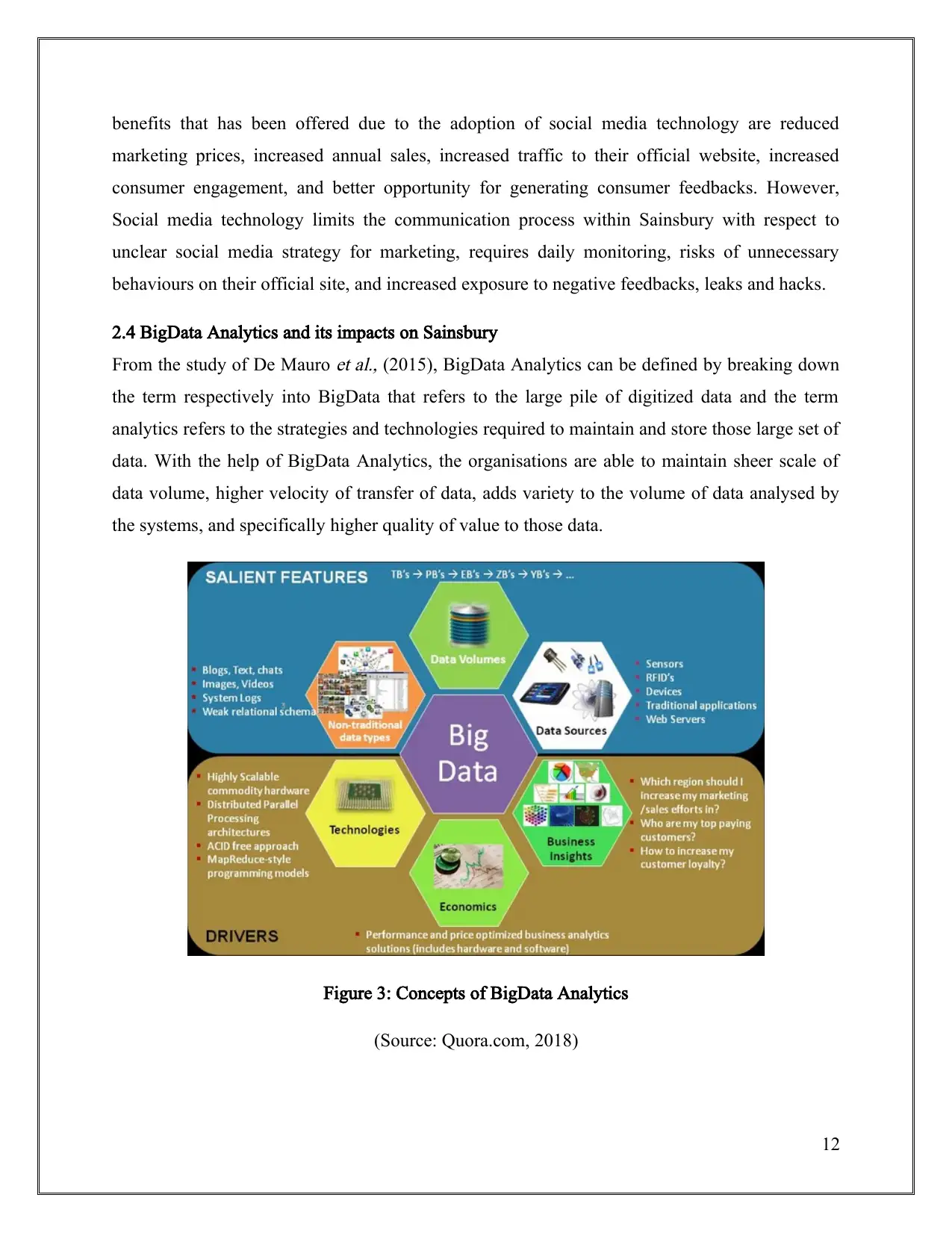
benefits that has been offered due to the adoption of social media technology are reduced
marketing prices, increased annual sales, increased traffic to their official website, increased
consumer engagement, and better opportunity for generating consumer feedbacks. However,
Social media technology limits the communication process within Sainsbury with respect to
unclear social media strategy for marketing, requires daily monitoring, risks of unnecessary
behaviours on their official site, and increased exposure to negative feedbacks, leaks and hacks.
2.4 BigData Analytics and its impacts on Sainsbury
From the study of De Mauro
et al., (2015), BigData Analytics can be defined by breaking down
the term respectively into BigData that refers to the large pile of digitized data and the term
analytics refers to the strategies and technologies required to maintain and store those large set of
data. With the help of BigData Analytics, the organisations are able to maintain sheer scale of
data volume, higher velocity of transfer of data, adds variety to the volume of data analysed by
the systems, and specifically higher quality of value to those data.
Figure 3: Concepts of BigData Analytics
(Source: Quora.com, 2018)
12
marketing prices, increased annual sales, increased traffic to their official website, increased
consumer engagement, and better opportunity for generating consumer feedbacks. However,
Social media technology limits the communication process within Sainsbury with respect to
unclear social media strategy for marketing, requires daily monitoring, risks of unnecessary
behaviours on their official site, and increased exposure to negative feedbacks, leaks and hacks.
2.4 BigData Analytics and its impacts on Sainsbury
From the study of De Mauro
et al., (2015), BigData Analytics can be defined by breaking down
the term respectively into BigData that refers to the large pile of digitized data and the term
analytics refers to the strategies and technologies required to maintain and store those large set of
data. With the help of BigData Analytics, the organisations are able to maintain sheer scale of
data volume, higher velocity of transfer of data, adds variety to the volume of data analysed by
the systems, and specifically higher quality of value to those data.
Figure 3: Concepts of BigData Analytics
(Source: Quora.com, 2018)
12
⊘ This is a preview!⊘
Do you want full access?
Subscribe today to unlock all pages.

Trusted by 1+ million students worldwide
1 out of 21
Related Documents
Your All-in-One AI-Powered Toolkit for Academic Success.
+13062052269
info@desklib.com
Available 24*7 on WhatsApp / Email
![[object Object]](/_next/static/media/star-bottom.7253800d.svg)
Unlock your academic potential
Copyright © 2020–2025 A2Z Services. All Rights Reserved. Developed and managed by ZUCOL.




